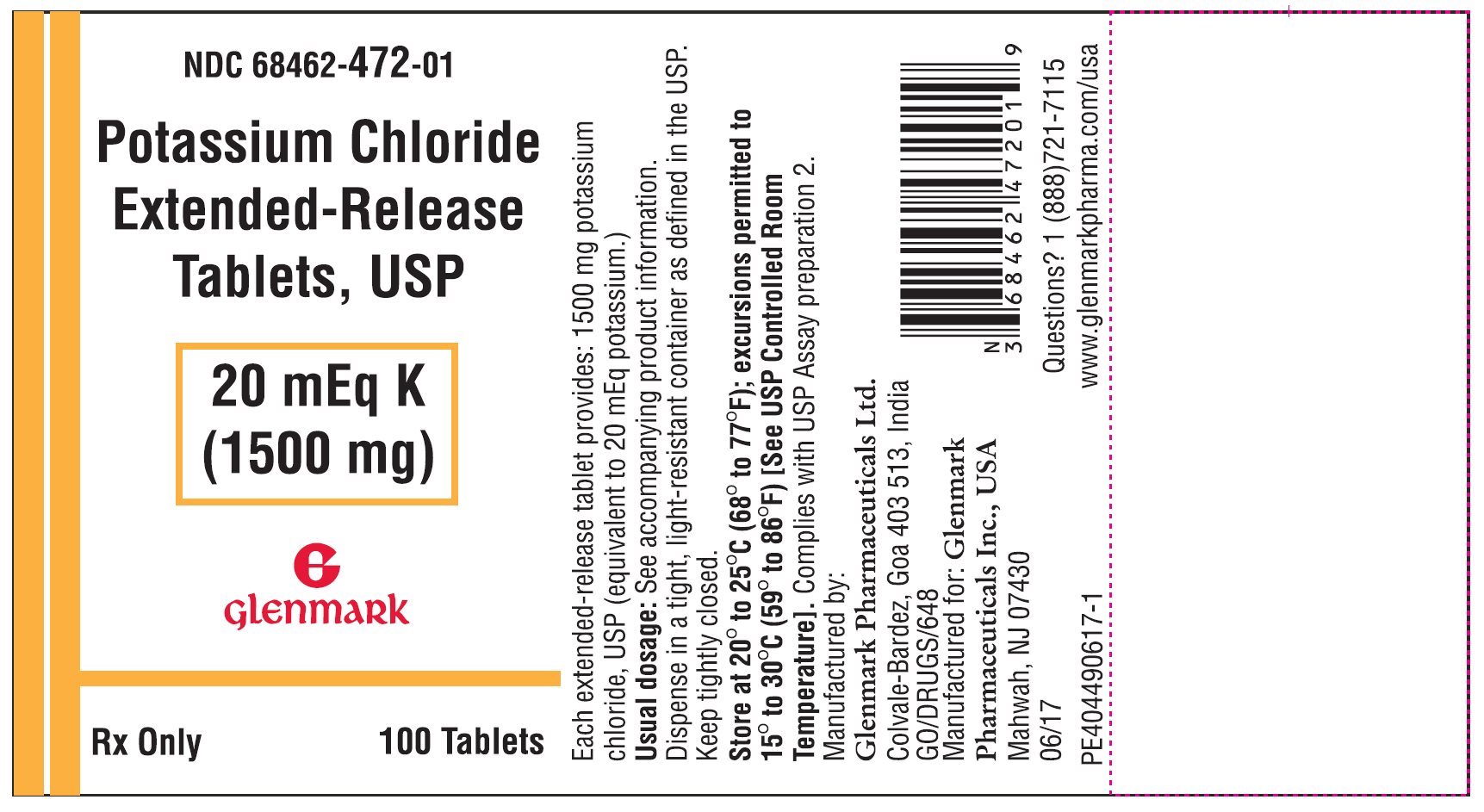Drug Catalog - Product Detail
POTASSIUM CHLOR ER TAB USP 10MEQ 100CT
| NDC | Mfr | Size | Str | Form |
|---|---|---|---|---|
| 68462-0471-01 | GLENMARK PHARMACEUTICALS | 100 | 10MEQ | TABLET |
PACKAGE FILES


Generic Name
POTASSIUM CHLORIDE
Substance Name
POTASSIUM CHLORIDE
Product Type
HUMAN PRESCRIPTION DRUG
Route
ORAL
Application Number
ANDA203562
Description
DESCRIPTION The potassium chloride extended-release tablets, USP 20 mEq product is an immediately dispersing extended-release oral dosage form of potassium chloride containing 1500 mg of microencapsulated potassium chloride, USP equivalent to 20 mEq of potassium in a tablet. The potassium chloride extended-release tablets, USP 10 mEq product is an immediately dispersing extended-release oral dosage form of potassium chloride containing 750 mg of microencapsulated potassium chloride, USP equivalent to 10 mEq of potassium in a tablet. These formulations are intended to slow the release of potassium so that the likelihood of a high localized concentration of potassium chloride within the gastrointestinal tract is reduced. Potassium chloride is an electrolyte replenisher. The chemical name of the active ingredient is potassium chloride, and the structural formula is KCl. Potassium chloride, USP occurs as a white, crystalline powder. It is odorless and has a saline taste. It is freely soluble in water and practically insoluble in ethanol. Potassium chloride is a tablet formulation (not enteric coated or wax matrix) containing individually microencapsulated potassium chloride crystals which disperse upon tablet disintegration. In simulated gastric fluid at 37°C and in the absence of outside agitation, potassium chloride tablets begin disintegrating into microencapsulated crystals within seconds and completely disintegrate within 1 minute. The microencapsulated crystals are formulated to provide an extended-release of potassium chloride. This product complies with USP assay preparation 2. Inactive Ingredients: crospovidone, ethylcellulose, hydroxypropyl cellulose, magnesium stearate, microcrystalline cellulose and talc.
How Supplied
HOW SUPPLIED Potassium chloride extended-release tablets, USP 20 mEq are available in bottles of 100 (NDC 68462-472-01) and 500 (NDC 68462-472-05). Potassium chloride extended-release tablets, USP 20 mEq are white to off-white, capsule-shaped biconvex tablets debossed with ‘472’ on one side and scored on the other side. Potassium chloride extended-release tablets, USP 10 mEq are available in bottles of 100 (NDC 68462-471-01) and 500 (NDC 68462-471-05). Potassium chloride extended-release tablets, USP 10 mEq are white to off-white, capsule-shaped biconvex tablets debossed with ‘471’ on one side and plain on the other side. Storage Conditions Keep tightly closed. Store at 20° to 25°C (68° to 77°F); excursions permitted to 15° to 30°C (59° to 86°F) [See USP Controlled Room Temperature].
Indications & Usage
INDICATIONS AND USAGE BECAUSE OF REPORTS OF INTESTINAL AND GASTRIC ULCERATION AND BLEEDING WITH CONTROLLED-RELEASE POTASSIUM CHLORIDE PREPARATIONS, THESE DRUGS SHOULD BE RESERVED FOR THOSE PATIENTS WHO CANNOT TOLERATE OR REFUSE TO TAKE LIQUID OR EFFERVESCENT POTASSIUM PREPARATIONS OR FOR PATIENTS IN WHOM THERE IS A PROBLEM OF COMPLIANCE WITH THESE PREPARATIONS. 1. For the treatment of patients with hypokalemia with or without metabolic alkalosis, in digitalis intoxication, and in patients with hypokalemic familial periodic paralysis. If hypokalemia is the result of diuretic therapy, consideration should be given to the use of a lower dose of diuretic, which may be sufficient without leading to hypokalemia. 2. For the prevention of hypokalemia in patients who would be at particular risk if hypokalemia were to develop, e.g., digitalized patients or patients with significant cardiac arrhythmias. The use of potassium salts in patients receiving diuretics for uncomplicated essential hypertension is often unnecessary when such patients have a normal dietary pattern and when low doses of the diuretic are used. Serum potassium should be checked periodically, however, and if hypokalemia occurs, dietary supplementation with potassium-containing foods may be adequate to control milder cases. In more severe cases, and if dose adjustment of the diuretic is ineffective or unwarranted, supplementation with potassium salts may be indicated.
Dosage and Administration
DOSAGE AND ADMINISTRATION The usual dietary intake of potassium by the average adult is 50 mEq to 100 mEq per day. Potassium depletion sufficient to cause hypokalemia usually requires the loss of 200 mEq or more of potassium from the total body store. Dosage must be adjusted to the individual needs of each patient. The dose for the prevention of hypokalemia is typically in the range of 20 mEq per day. Doses of 40 mEq to 100 mEq per day or more are used for the treatment of potassium depletion. Dosage should be divided if more than 20 mEq per day is given such that no more than 20 mEq is given in a single dose. Each potassium chloride extended-release tablet, USP 20 mEq provides 20 mEq of potassium. Each potassium chloride extended-release tablet, USP 10 mEq provides 10 mEq of potassium. Potassium chloride tablets, USP should be taken with meals and with a glass of water or other liquid. This product should not be taken on an empty stomach because of its potential for gastric irritation (see WARNINGS ). Patients having difficulty swallowing whole tablets may try one of the following alternate methods of administration: 1. Break the tablet in half, and take each half separately with a glass of water. 2. Prepare an aqueous (water) suspension as follows: 1. Place the whole tablet(s) in approximately 1/2 glass of water (4 fluid ounces). 2. Allow approximately 2 minutes for the tablet(s) to disintegrate. 3. Stir for about half a minute after the tablet(s) has disintegrated. 4. Swirl the suspension and consume the entire contents of the glass immediately by drinking or by the use of a straw. 5. Add another 1 fluid ounce of water, swirl, and consume immediately. 6. Then, add an additional 1 fluid ounce of water, swirl, and consume immediately. Aqueous suspension of potassium chloride that is not taken immediately should be discarded. The use of other liquids for suspending potassium chloride tablets, USP is not recommended.
